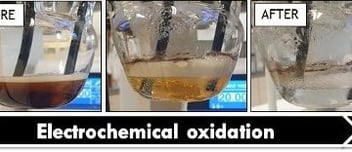Electric bugs: A new approach to resource recovery
Microbial electrochemistry (using bacteria to produce electricity directly from effluent streams) holds great potential in wastewater treatment. We spoke to a leader in the field to find out what’s driving research.
Wastewater treatment facilities are under more pressure now than ever before. As populations increase and assets age, treatment process capabilities are being challenged significantly. And there’s also energy consumption to consider, too.
Nestled within the Advanced Water Management Centre at the University of Queensland, Dr Stefano Freguia’s goal is to develop technology that can be applied to resource recovery and sustainable asset management. And while his field of research – microbial electrochemistry – is only about a decade old, the results achieved thus far promise some truly extraordinary applications.
“Microbial electrochemistry is about understanding the interaction between bacteria and electrodes – solid surfaces that are able to conduct electricity,” Freguia said.
“We have been exploring how bacteria can chew up organic matter in wastewater, converting it into electricity. The potential is to have a system that treats wastewater while generating, rather than consuming, electricity. This area of research took off worldwide when people realised there was the potential to create revolutionary wastewater treatment technology.”
While energy-creating wastewater treatment sounds like a utility’s dream come true, there’s definitely a catch: not all technology is commercially competitive. Freguia said the cost of applying the technology to large-scale sewage treatment was one of a few challenges they faced.
“Initially, we believed we could turn this idea into a viable technology that could generate electricity out of wastewater. There’s been a lot of success towards that but some issues have come up,” he said.
“We built the first pilot in 2007 and, although we showed we could scale it up, it was clear that the cost would never be competitive with existing technology. We also found issues with addressing pollutants; it is not able to address nutrient removal and also the removal of organics is not perfect.”
Changing direction
“That’s when things started to shift. We turned to considering what else we could do with this concept. And the first thing we did was starting to look at different types of wastewater,” Freguia said.
Freguia said he and his fellow researchers began looking for saltier wastewater sources, as the higher concentration of ions make them highly conductive.
“Urine is very salty. It contains a lot of nutrients. It has plenty of organics too,” Freguia said.
“We tried the process out on human urine and found it was working really well and at a much higher rate than we were getting with sewage. That was pretty encouraging, but then we also modified the original idea in a way that we could begin to capture the nutrients too. This is one of the major directions that we have taken now.”

Freguia said the process works similarly to electrodialysis – moving salt ions in water through the application of electricity – with the main difference being that the new technology is self-driven and energy neutral.
“In electrodialysis, we apply a lot of electricity to concentrate nutrients and be able to harvest them. Here, the energy comes from the urine itself. We have now created a technology which is able to recover nutrients, pulling them out of the urine stream using its own energy to do so.”
While the urine study started as an alternative due to financial constraints, it now has the potential to not only become a key feature in saving utilities’ energy costs in future, but also poses a solution to nutrient recovery.
“About 25% of the total energy to run a wastewater treatment plant is attributed to nutrient removal. It’s quite significant,” Freguia said.
“Most of the nutrients that come to a sewage treatment plant come from urine itself. If we could pull those out at the source with this technology, which does not require any energy, it could significantly lower electricity requirements to run the wastewater treatment process.”
Every last drop
The urine study now faces one key problem: source separation. Figuring out this step will be key not only to making the process financially viable, but also to find use for the by-product.
“There are a lot of water-less urinals installed in airports. At the moment, it’s just a measure to save water, so the urine is collected separately but immediately mixed back with the rest of the wastewater. We are proposing to start from those selected locations that are already using urine separation to apply our new concept,” Freguia said.
“We would like to use our results as a way to promote source separation, especially in large buildings.”
Aside from aiding energy-use reduction, another benefit of source separation is harvesting nutrients, as the by-product of the electrochemical process is rich in nutrients that are readily available for plant growth. Freguia said the fertiliser is fast release and would work very well with hydroponics.
“We think that concentrate could be used as a fertiliser for gardens. From there, it could be applied to horticultural farming, where you need to add the nutrients at the time the fruits are being produced,” Freguia said.
“The key with this by-product is that it’s quite concentrated, but it’s also clean; it does not contain any significant amount of micropollutants, such as pharmaceuticals, that you’d have in the pre-treated urine. It does not contain harmful microorganisms or pathogens, either.
“We need to figure out what we can do with the product, as this will be key to having the technology taken up by industry.”
First published in Current magazine February 2017.

